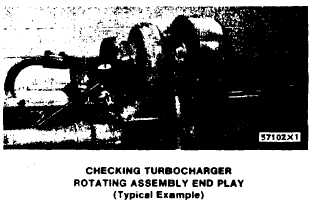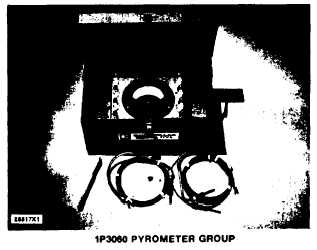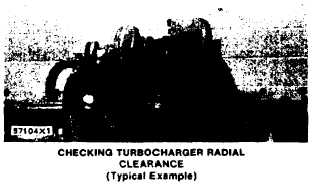AIR INLET AND EXHAUST SYSTEM
TM 5-3805-263-14&P-2
TURBOCHARGER
Every 7200 hours or if any unusual sound or vibra-
tion in the turbocharger is noticed, a quick check of
bearing condition can be made without disassem-
bling the turbocharger. Remove the piping from the
turbocharger and inspect the compressor impeller,
turbine wheel and compressor cover. Rotate the
compressor and turbine wheel assembly by hand and
check for too much end play and radial clearance.
The rotating assembly must rotate freely with no
rubbing or binding. If there is any indication of the
impeller rubbing the compressor cover or the turbine
wheel rubbing the turbine housing, recondition the
turbocharger or replace with a new or rebuilt one.
End clearance is best checked with a dial indica-
tor. Install a dial indicator with the indicator point
on the end of the shaft. Move the shaft from end to
end making note of the total indicator reading. End
play for the Turbocharger is .001 to .004 in. (0.03 to
0.10 mm).
If end play is more than the maximum end play
rebuild or replace the turbocharger. End play less
than the minimum end play can indicate carbon
build up on the turbine wheel. Disassemble for clean-
ing and inspection.
A more reliable check of bearing condition can be
made only when the turbocharger is disassembled
and the bearings, shaft journal and housing bore
diameters can actually be measured.
TESTING AND ADJUSTING
Radial clearance can also be checked with a dial
indicator. Remove the oil return line from the turbo-
charger. Install a dial indicator with an extension in-
dicator point long enough to contact the shaft
through the oil return hole. Make sure the contact
point is centered on the shaft (highest indicator
reading). Raise both ends of the shaft all the way
then push down in the opposite direction. If radial
clearance is more than .006 in. (0.15mm) or mini-
mum clearance is less than .003 in. (0.08mm), the
turbocharger must be disassembled and the bear-
ings checked.
NOTE: Care must be taken not to cock the shaft or a
false reading will be obtained.
CRANKCASE (CRANKSHAFT
COMPARTMENT) PRESSURE
Pistons or piston rings that have damage can be
the cause of too much pressure in the crankcase. This
condition will cause the engine to run rough. There
will also be more than the normal amount of fumes
coming from the crankcase breather. This crankcase
pressure can also cause the element for the crankcase
breather to have a restriction in a very short time. It
can also be the cause of oil leakage at gaskets and
seals that would not normally have leakage.
Normal crankcase pressure with a clean crankcase
breather is 2 in. (50.8 mm) of H2O or less.
MEASUREMENT OF EXHAUST
TEMPERATURES
Use the 1P3060 Pyrometer Group to check ex-
haust temperature.
1-58





